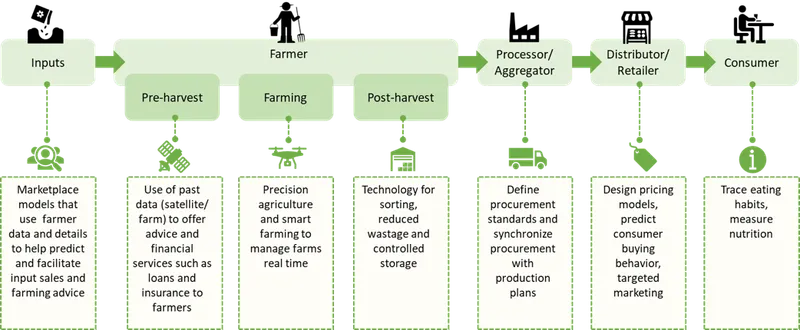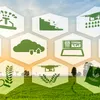Agritech trends: Use of data science in agriculture
The time is ripe for the Indian agricultural sector to adopt best practices by using data science, deploy smart farming techniques and build integrated supply chains to boost productivity.
Importance of agriculture and the current landscape
Agriculture and allied sectors in India employ about 50% of India’s workforce. Yet, it contributes to less than a fifth of the GDP. An average farmer in India earns less than US$ 2000 per annum, compared to the United States of America, where the Food and Agriculture sector contributes ~US$ 1tn to the GDP and employs roughly 25 million people, directly and indirectly.
The Food and Agriculture per capita GDP in the US is ~ US$ 40,000. Even with the largest area of land under agriculture in the world, agricultural yield per hectare is still low for major crops in India. The gap in productivity and efficiency in the Indian farm and agriculture sector is a glaring one.
Farm productivity and farmer income in India is plagued with several challenges – marginal land holdings of farmers making mechanisation difficult and implementation of technology difficult or unviable, timely access to genuine and high quality inputs and farming advice, heavily intermediated supply chains, dependence on monsoon rains, and inadequate storage facilities.
Furthermore, farmers lack institutional support in terms of access to financial services (loans, insurance) and capacity building. With their incomes already under pressure, farmers are unable to modernise agricultural practices to improve yield.
Demand for food continues to increase as the population grows. Productivity challenges in the agricultural sector need urgent solutions. Even as basic food security is achieved, changing consumer preferences are leading to rising demand for healthy, fresh, and nutritious food options beyond just carbohydrates.
Conscious consumers want to know how and where their food has been produced, processed, and stored before it reaches their table.
Data science and its uses to address the agriculture sector’s challenges
Data science is the method of gleaning insights from data. It enables the use of real-time data and past data to form meaningful insights on buyer behaviour, customer credit behaviour, product testing, cropping patterns, and others.
Data science already plays a significant role in banking and healthcare, both in India and globally. The principles of data science could also be applied to the Indian agriculture industry across the value chain from the farm through retail.

Data science applications in Agriculture
Illustration by Zephyr Peacock
Improving yield and productivity
One of the challenges Indian farmers face is lack of access to best practices from sowing to harvesting and storage. Farmers have to tailor the choice of crop and crop care techniques to the soil and weather conditions of their land to derive the most yield.
Data science can provide actionable insights bespoke to farmers’ land and ownership pattern on what to plant, when to plant, and what farm practices to deploy. Making well-informed decisions could save costs and enhance a farmer’s profitability and income.
Enabling smart farming
Solutions to enable real-time monitoring of farms will help farmers deploy corrective measures on time. For example, early disease detection in crops and monitoring soil moisture levels in farms for optimised yield.
Smart farming helps farmers monitor relevant parameters continuously through IoT-enabled solutions. These solutions may also help farmers automate and optimise processes such as pesticide spraying, irrigating, rejuvenation of soil, and other such activities.
Financial solutions for farmers
Banks and other financial institutions do not have adequate data on crop performance and farmer incomes. Data science solutions on farmlands and cultivation trends can help financial services companies to improve their underwriting of loans and insurance products for agri-related financing.
High variable costs and limited access to underwriting data make lending and insuring farmers an unviable business, particularly in India where majority of farmers own small tracts of land.
However, new-age solutions are now using satellite imagery and combining non-traditional data sets such as weather data and satellite imagery to track cultivation progress and weather patterns. Such solutions can help predict farm-level yields and enable financial institutions to help farmers with insurance products and loans for working capital and capex for farmlands.
Building integrated supply chains
COVID-19 has emphasised the need to build integrated supply chains. Crisis or not, you still need food on the table. Data-led and tech-enabled processes enhance procurement capabilities, farm-level traceability, and tracking, thereby ensuring a smoother supply chain and helping reduce food wastage.
Business models in other markets have proven the viability of using data in agriculture. Several companies have recognised these applications of data science to solve agricultural challenges.
For instance, Monsanto, a leading agricultural company, acquired Climate Corp, a digital agriculture company that uses weather, soil, and field data to help farmers make optimal farming decisions. DuPont acquired , Inc., a provider of software and analytics tools that help farms improve efficiency, profitability, and sustainability. The last decade has also witnessed an increase in agri-tech investing by sector-focused and early-stage generalist funds.
Why now
India has the second-largest road network in the world. Connectivity between cities, towns, and rural markets has also gradually improved over the last decade. Most Indian villages now have access to electricity. Infrastructure in India is ready to give a digital makeover to the agriculture sector.
India has over 1 billion mobile phone connections and over 500 million smartphone users. Backed by the lowest mobile data rates in the world, India is more than ready for digitisation.
Road ahead
The cost of mobile data and technology costs (IoT devices, controllers, chipsets) have significantly reduced over the last decade. Smartphone penetration and the use of mobile devices would continue to rise. India is rapidly digitising, and this will produce vast quantities of data.
The number of companies that use data to improve farmer incomes and farm productivity is on the rise. The digital revolution of the agricultural sector has already begun, and many innovative businesses will find their niche while collectively addressing the sector’s most pressing needs.
(Disclaimer: The views and opinions expressed in this article are those of the author and do not necessarily reflect the views of YourStory.)









